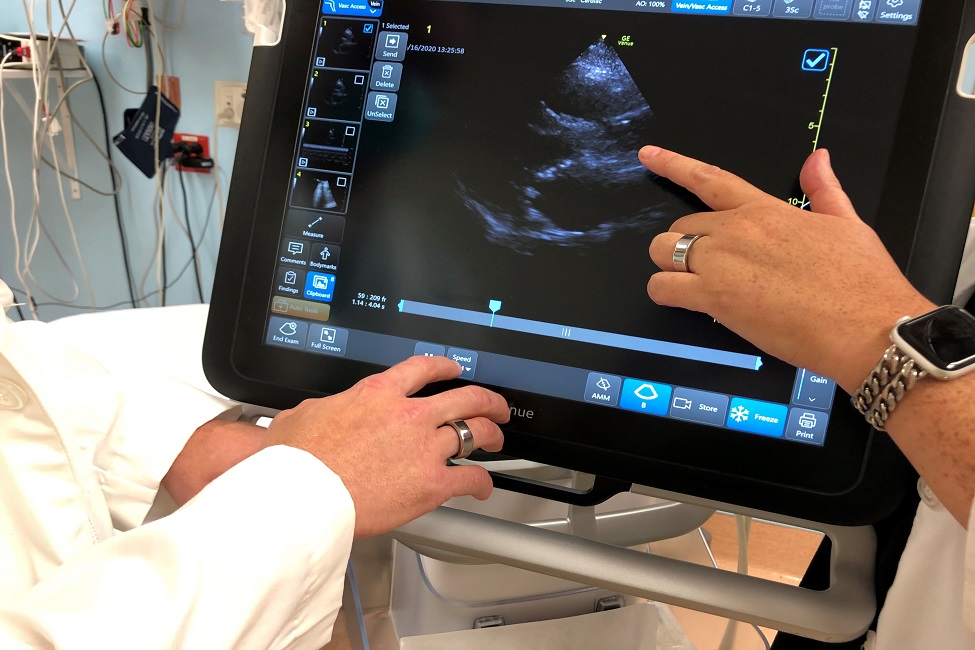‘With This Ring,’ Scientists Hope to Predict COVID-19

The thick, silver Oura ring, which resembles a wedding band, is worn around-the-clock to continuously provide data in real-time. The data alerts the user and the researchers of physiological changes that might indicate that they are developing an infection.
A team of scientists from Florida Atlantic University’s Schmidt College of Medicine is implementing a three-pronged approach to predict coronavirus disease (COVID-19) infection in healthcare workers on the frontline of the pandemic. They recently launched a study designed to identify patterns of onset, detection, progression, and recovery from COVID-19 by observing body temperature, heart rate, breathing rate and related measures, as well as illness symptoms such as fever, cough, and fatigue. Ultimately, the researchers hope to better identify patterns that could predict the emergence and recovery from novel infections and thereby prevent and contain future pandemics.
At the center of it all – a ring. Led by Janet Robishaw, Ph.D., principal investigator, senior associate dean for research and chair of the Department of Biomedical Sciences in FAU’s Schmidt College of Medicine, the FAU research team is part of a global study, TemPredict, spearheaded by the University of California San Francisco (UCSF). TemPredict includes two groups: frontline healthcare workers and the general population. The study uses a smart ring, the Oura ring, which tracks the body’s heart rate, temperature, movement and sleep to determine whether the physiological data it collects combined with responses to daily symptom surveys, can predict illness symptoms. The thick, silver ring, which resembles a wedding band, is worn around-the-clock to continuously provide data in real-time. The data alerts the user and the researchers of physiological changes that might indicate that they are developing an infection.
“We were very interested in the Oura ring because it provides continuous information that is very instructive in helping people understand that they might be getting sick without even realizing it,” said Robishaw. “However, as scientists, we also recognized that we need to be able to correlate the data from this ring to determine whether these people go on to develop an infection. Otherwise, it is unclear that the change in the data is indicative of anything.”
The FAU research team has taken TemPredict to the next level by incorporating two additional phases: determining if study participants go on to develop an acute COVID-19 infection and understanding the prevalence rate in that population. They are in the beginning phase of the study with clinical physicians, resident physicians and fellows from FAU’s Schmidt College of Medicine who are caring for patients on the frontline of the pandemic. During the course of the 12-week study, participants will undergo weekly viral testing to detect if they have an acute COVID-19 infection.
The FAU research team has developed a novel COVID-19 viral test that uses a saliva sample instead of a sample obtained with a nasal swab. Their method uses molecular detection via polymerase chain reaction (PCR) and does not require critical reagents in short supply. Furthermore, because study participants can collect their own saliva sample, this test eliminates potential virus exposure to others.
Massimo Caputi, Ph.D., a professor of biomedical sciences in FAU’s Schmidt College of Medicine, and his students Christopher Mauer, Anastasia Ritchie and Sean Paz, went back to “old school” research to develop the testing kit, which detects COVID-19 with accuracy and sensitivity that rivals other tests. This is a research test and is not commercially available for clinical use.
At six and 12-weeks, the researchers will conduct serologic (blood) tests to identify whether the study participants have developed an immune response to COVID-19. These antibodies show up in the bloodstream around three to six weeks from when a person was exposed to the COVID-19 infection and developed an immune response.
“It is important to note that there are numerous COVID-19 virus and antibody testing kits on the market right now and a large proportion of them are not reliable or have not been validated appropriately,” said Robishaw. “Research matters to combat this crisis and to come up with solutions for this pandemic. We are hopeful that results from our study will lead to new and improved clinical and diagnostic testing in the future.”
The project team, which includes Vijaya Iragavarapu, Ph.D., a professor of biomedical science with extensive experience in tumor immunology, tumor biology and molecular cell biology, who is spearheading the antibody testing for the study; and Joanne B. Krasnoff, Ph.D., director, Learning Health Center for Research and Education and a research assistant professor of biomedical science, will join forces with the Machine Perception & Cognitive Robotics Lab (MPCR) in FAU’s Charles E. Schmidt College of Science to incorporate machine learning or artificial intelligence (AI) to identify patterns that predict if someone was developing an infection from COVID-19 and correlate that data with the saliva and antibody test results. The research team also will have the ability to correlate their data to the larger TemPredict study of more than 2,000 healthcare workers — doctors, nurses, and others — who are in daily contact with patients who may be afflicted with COVID-19.
“Dr. Robishaw and her team felt very strongly about the importance of including FAU physicians in the study because these doctors put their lives on the line every day caring for patients in our community,” said Phillip Boiselle, M.D., dean of FAU’s Schmidt College of Medicine. “We are hopeful that results from this study will help to alert physicians and other healthcare workers of an impending COVID-19 infection so that they can self-isolate early and receive appropriate treatment in a timely manner.”
The research team expects to recruit approximately 200 participants for the study. As funding becomes available to purchase additional Oura rings, Robishaw hopes to extend the study to assisted living and skilled nursing facilities.
-FAU-
Tags: faculty and staff | technology | research | medicine | coronavirus